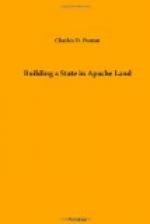We were very much disappointed at its meagerness, and especially that the boundary did not include a port in the Gulf of California. A larger territory could have been secured as easily, but the American Minister had only one idea, and that was to secure “a pass” for a Southern Pacific Railroad from the Mississippi River to the Pacific Ocean. The pass desired was the Guadaloupe Canon, used as a wagon road by General Cook in his march from New Mexico to California in 1846, and strange to say, not subsequently occupied as a railroad pass.
The country south of the new boundary line is not of much consequence to us: it belongs to Mexico.
The country north of the Mexican boundary is the most marvelous in the United States. After many years of arduous investigation and comparison with all the other countries of the world, it is still nearly as great an enigma as when first explored in 1854. The valleys are as fair as the sun ever shone upon, with soil as productive as the valley of the Nile. The rigors of winter never disturb agricultural pursuits in the open. In fact, in the southern portion of the territory there is no winter.
The valleys of Arizona are not surpassed for fertility and beauty by any that I have seen, and that includes the whole world; but still they are not occupied. Spanish and Mexican grants have hung over the country like a cloud, and settlers could not be certain of a clear title. Moreover, the Apaches have been a continual source of dread and danger. This state of affairs is, however, now passing away.
There were evidences of a recent Mexican occupation, with the ruins of towns, missions, presidios, haciendas, and ranches. There were evidences of former Spanish civilization, with extensive workings in mines. There were evidences of a still more remote and mysterious civilization by an aboriginal race, of which we know nothing, and can learn but little by the vestiges they have left upon earth.
They constructed houses, lived in communities, congregated in cities, built fortresses, and cultivated the soil by irrigation. No evidence has been found that they used any domestic animals, no relic of wheeled vehicles, neither iron, steel, nor copper implements; and yet they built houses more than five stories high, and cut joists with stone axes.
How they transported timbers for houses is not known. The engineering for their irrigating canals was as perfect as that practiced on the Euphrates, the Ganges, or the Nile. The ruins of the great houses (casas grandes) are precisely with the cardinal points.
Near Florence, on the Gila, is beyond all doubt the oldest and most unique edifice in the United States. Just when and how it was built baffles human curiosity. Whether it was erected for a temple, a palace, or a town hall, cannot be ascertained. The settlement or city surrounding the ruin must have occupied a radius of quite ten miles, judging from the ruins and pieces of broken pottery within that space. An irrigating canal formerly ran from the Gila River to the city or settlement, for domestic uses and for irrigation.




